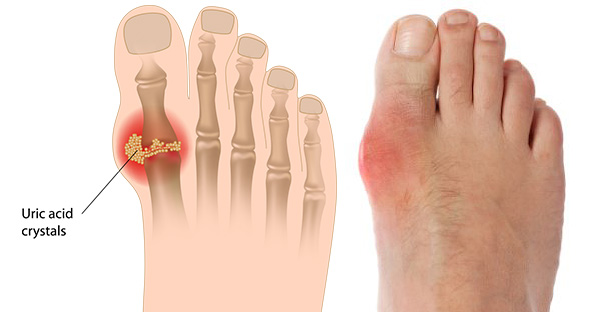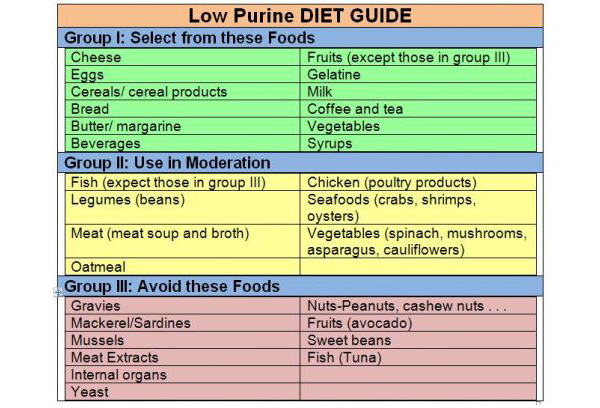Gout is a form of arthritis that is characterized by sudden, severe attacks of pain, redness and tenderness in joints. The cause of gout is an excessive blood level of uric acid (hyperuricemia), a waste product formed from the breakdown of purines. These are substances found naturally in your body as well as in certain foods. When hyperuricemia is present, the uric acid which is normally dissolved in the blood may, from time to time, form microscopic crystals that precipitate in the joint. Gout usually affects only one or two joints at a time – most often the feet and ankles. The big toe joint is the most common site, known as Podagra. Without treatment, the attack subsides in a week or so. When patients first develop gout, there may be intervals of many months or even years between attacks. As time goes by and uric acid levels are not well controlled, episodes of gout tend to become more frequent and more severe. Eventually many joints may be involved, sometimes all at the same time. At this stage, a state of chronic or continuous joint disease may develop with progressive joint damage, disability, and crippling (chronic gout).

Uric acid crystals are deposited in the joint during an acute gout attack. The big toe joint is commonly involved.
Gout affects mostly men and is very rare in women until after the menopause when it is quite often seen in women. It is very common in New Zealand and it is particularly common in Maoris and Pacific Islanders. Some surveys have shown it to be present in up to 10% of adult males.

Uric acid crystals can be seen under the microscope following aspiration of joint fluid – one of the ways to detect gout.
Gout develops in patients whose uric acid is higher than normal. There are many causes of this. The following are some of the more common causes:
- Higher than normal levels of uric acid can be part of the inherited make-up of some families.
- Obesity.
- High alcohol intake.
- High intake of food containing purines (see below).
- Some of the drugs used to treat high blood pressure.
- Less commonly, longstanding kidney disease may result in high blood levels of uric acid.
Treatment
Treatment of gout used to include severe dietary restrictions but medications to treat gout have reduced the need for such restrictions. However, dietary modifications will help reduce the severity and frequency of gout attacks.
This is also useful for people who have problems with gout medications. Smaller amounts of purines are found in all meats, fish and poultry. For this reason, patients with history of gout should limit animal protein in their diet to no more than 6 ounces of lean meat, poultry, or fish per day. Some additional dietary considerations include:
- Avoid alcohol or drink it in moderation. Drinking too much alcohol increases the risk of hyperuricemia because it interferes with the removal of uric acid from the body.
- Drink plenty of fluids and water (just not alcohol). It can help remove uric acid from the body.
- Maintain a healthy weight. Excess weight puts more stress on your joints and increases the risk of hyperuricemia and gout.
- Lose weight if you’re overweight. But avoid fasting or rapid-weight-loss diets because they can increase uric acid levels in the blood. Also, avoid low-carbohydrate diets that are high in protein and fat, which can increase the risk of hyperuricemia and exacerbate gout.

Anti-Gout Diet.
Treating the Acute Attack
Anti-inflammatory drugs (NSAIDs) can be very effective, but to gain the best results the dose should be adequate and the drug taken as soon as possible at the first sign of an attack. Therefore, medical advice must be sought early. With effective treatment the attack may be controlled within 12-24 hours and treatment need not be continued after a few days. Rest and elevation of the joint involved and increase fluid intake by an extra 4 to 5 glasses of water a day are also important. Drugs used for the acute attack have no effect on reducing uric acid levels long term.

How to Lower Uric Acid (Hyperuricemia)
If in spite of all the measures above the uric acid remains high and attacks continue or become more frequent, other drugs can be used which directly lower the blood uric acid. However, it must be understood that these drugs have no effect on the actual attacks of acute gout and they must be taken on a continuous and long term basis. The dose must be adjusted by repeated checks on the blood uric acid before a permanent maintenance dose can be decided on. Once the uric acid is down within normal limits, patients should remain free from gout provided the drug is continued. Some drugs work by increasing elimination via the kidneys and others by blocking uric acid formation. You should discuss your family doctor regarding anti-gout medications if you suffer from frequent episodes of gout unimproved with diet and exercise.
If you are suffering from gout or joint pain as a result of gout attacks, contact our office for a consultation with our doctor.

